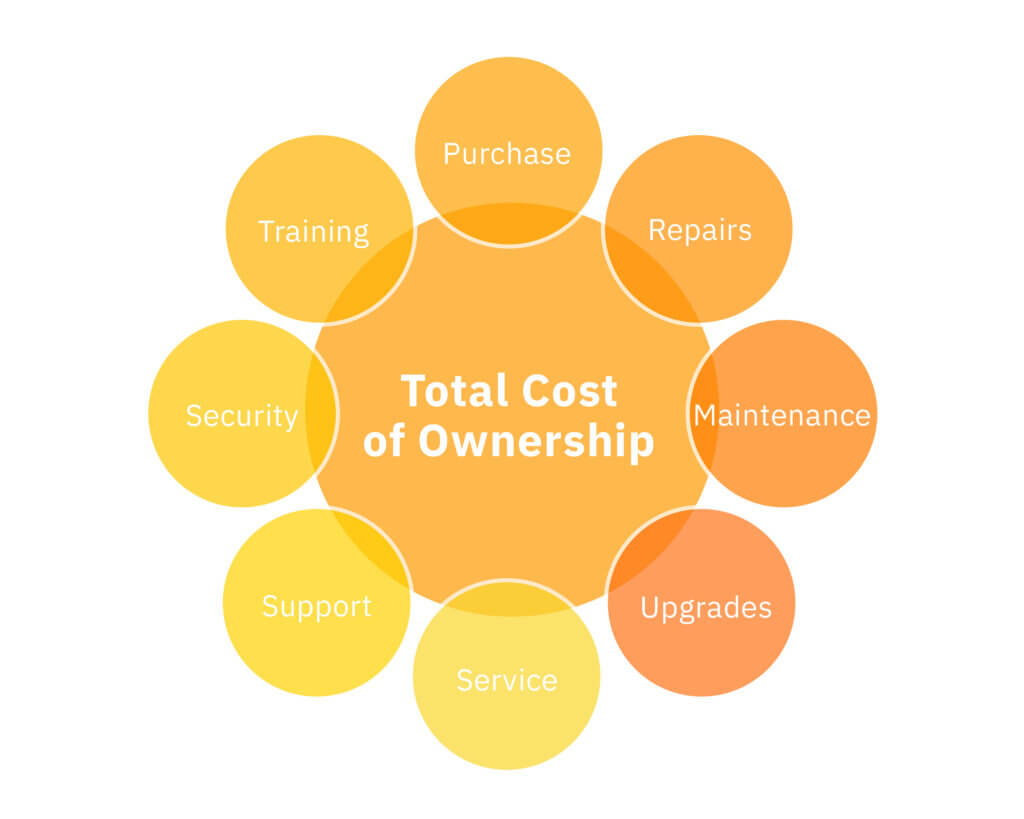Understanding the Total Cost of Ownership – an Example
What does the total cost of ownership mean to anyone who runs a business or an enterprise? When companies make purchases, the concept of the total cost of ownership is often left out. People focus only on the buying price they see on the price tags.
For example, an office is purchasing a printer; your favourite model, we would need to pay for the price of that printer. This price that you have to pay is the purchasing price. But that is not all because we would need to transport this printer from our supplier’s store to the office. That is extra cost number one, transportation cost. Remember, this cost you incur immediately after the printer gets into your possession.

Hidden Extra Costs
Now, our printer reached your office and is sitting on top of your desk. The first thing you need to do is power it on. You look for the nearest wall socket. You plug it in and are pleased that the printer you bought is now in front of you. The second extra cost just checked in is power (electricity) to run the printer. Before you print any document, you remember that you need to have some printing papers. Head over to your stationers section and grab some ream of printing paper.
Extra cost number three just kicked in. A few months down the line, after some massive printing, the printer runs out of ink. You need to replace the cartridges to fill the ink tank. Extra cost number four just secured a slot in your month’s expenses in running the office. Remember, there is also the maintenance cost that you will get to foot along the way.
As you sit down and reflect, you realize that you have already spent more on this printer than you expected. Your first budget was spending around €200 on purchasing your printer, but as it stands, you have incurred more on the item you purchased.
ToolSense is trusted by 700+ companies



KEY TAKEAWAYS
- The total cost of ownership (TCO) is made up of the purchase price of a particular asset and the operating costs over its lifetime.
- Businesses use TCO as a means of analysing financial statements. Individuals use TCO to evaluate potential purchases.
- Looking at TCO is one way to assess the long-term value of a purchase to a business or individual.
What Is the Total Cost of Ownership?
TCO is mainly related to the Iceberg logic. You are attracted to the buying price, which is a short-term cost, without considering long-term costs. Such as upgrade costs, time spent in upgrading software and hardware. In this context, the tip of the iceberg represents the purchase price, while the other expenses represent the other massive part of the iceberg. Looking at it this way gives you a broader perspective of how you tackle some purchases.
The total cost of ownership analysis is highly applicable in the IT industry than any other sector. Therefore, we can define TCO as an in-depth analysis and comparison between short-term and long-term costs one is most likely to face before, during, and after acquiring a particular item, property, or assets. Some could define total cost of ownership as a summation of the acquisition price (purchase price) and associated fee or operational costs that one may incur later on.

The History Behind TCO
Back in the mid-80s, operational managers in the ICT industries started pointing out the enormous costs that hit them after acquiring hardware and software for the company. Most of the companies noticed that to support the smooth running of these newly acquired assets, they had to cough between 5 to 8 times more in support than the acquisition value. In almost every scenario, associated costs get so low by far compared to the maintenance costs.
This analysis can be beneficial to decision-makers in a variety of ways. The total cost of ownership TCO study could assist in making significant lease vs. buy decisions. Considering this factor in the purchasing process directly impacts the vendor selection process, capital acquisition prioritizing, and overall corporate budgeting.
TCO in IT Companies
In an IT set up, the option of going for new hardware or software may cost the company quite a fortune. When a company is considering the purchase of a new hardware or software upgrade, this is measured in terms of TCO. The question is whether the added value for the company from these purchases exceeds the total cost of operating the hardware or software.
When performing a TCO analysis, the following must be considered before purchasing new hardware or upgrading software. What resources are needed to operate the new hardware or software? Does the company have to train its employees on using them? Are there license fees that would need to be purchased? What would be the installation fees?
How much would it cost the company to migrate from the legacy options to a new possibility? In case of any technical glitches, what would be the financial implication that the company would face? How much would it cost to put the most secure security measure to prevent loss of data?
If something gets introduced to the company and the employees are unfamiliar with it, be it hardware or software, how much time, effort, and funds will it take for the employees to be familiar with it? The questions would go on and on.
Later on, in time, firms thought of starting outsourcing for some services that may be cheaper and easier to run than acquiring them. For example, it proved pretty easy to incorporate cloud hosting in businesses than having an in-house physical server.
TCO Software Programs
The cloud service providers would charge companies monthly fees that include technical support if a company faces issues and needs debugging. Even though the clouding solution got rid of some aspects that could be increasing costs, it’s still a complicated field in determining the total cost of the competition.
On the other hand, software acquisition has improved as time goes by. Software programs being bought in the past would just have to be used until it comes obsolete. But nowadays, companies are selling software products on a subscriptions’ basis.
And in order or make sure that they can retain their clients, these companies try as much as possible to include feature updates to their software programs now and then. As a successful strategy, most companies want to stay ahead of the game by having the latest tools to achieve the best from their team, so they always go for subscriptions with the latest updates and features.
What Is the Objective of Calculating TCO in IT?
Companies in the IT industry, use this method to highlight all the expenses incurred before, during, and after purchasing a product. It plays a vital role in accounting by highlighting the profits and losses incurred along the way.
Total Cost of Acquisition Example in IT
For this case, let’s look at a scenario where a company wants to purchase a new computer system to run its operations. The computer system already has a purchase price, which will be the initial cost to be incurred. Then comes some other factors like getting new software products that may be needed to run the system. There will be installation and transitional costs. Staff would need to be trained for the new system, and new security measures would need to be implemented to match the new system.
The most recurring cost would be the maintenance cost, since this has to be done more frequently to keep up with updates and so on. Individuals consider the entire cost of ownership when buying smaller-scale purchases. While the total cost of ownership is frequently overlooked, focusing just on the immediate direct costs might lead to future losses.

Points to Note When Making Purchases in IT
When you want to make purchases in IT, ask yourself what hardware or software you may need in addition to what you are purchasing. Think for a while about the maintenance and services costs that may occur along the way. Maintenance may include frequent software updates or even doing upgrades. Another factor is administrative costs. Will you need to hire someone with the required skills to manage that system? Or you’ll have to train your staff.
Calculating the Total Cost of Ownership When Buying a Car
If you are thinking of buying a car, the total cost of ownership is an important metric to consider. The total cost of ownership is essentially the total of how much money it will cost you over time to own and operate your vehicle. Many people think that they can simply look at the sticker price, and they have their answer. However, this doesn’t include all possible costs of owning a car, such as gas or parking fees.
The total cost of ownership is a metric that considers the initial purchase price and other factors such as fuel costs, insurance costs, and maintenance costs. It helps consumers make more informed decisions when choosing a car to buy.
Using this guide, you’ll be able to determine what your total cost of ownership will be for any new or used vehicle purchase. All cars depreciate over time, depreciate at different rates than others.
TCO Calculation
Depending on the type of car you purchase, there are various hidden costs associated with ownership. Some cars cost more to insure than others. If you lease your vehicle, you’ll likely pay a monthly charge in addition to the initial payment. You could also be required to cover excess wear and tear or damage beyond the vehicle’s everyday use. Plus, if you finance your car rather than pay cash for it upfront, you will have to make monthly payments until the loan is paid off, increasing the number of costs you will incur.
Car dealers sometimes understand that most buyers prefer to pay for their rides in monthly payments, which is why they list the MSRP (Manufacturer’s Suggested Retail Price) on auto loans. But even if you can manage to pay cash, there are still several other costs associated with buying a car. If you plan to finance or lease your next vehicle, here’s what you will need to know about calculating the total cost of ownership when purchasing a new or used car.
When buying a car, for example, consumers must consider the full cost of ownership. The total cost of ownership includes the purchase price and other costs such as maintenance, parking fees, insurance, and fuel.
New and used cars are often compared when consumers consider acquiring a vehicle. A total cost of ownership analysis is necessary for making this judgment because it considers the total costs over the car’s lifetime, not just its purchase price. It is significant to weigh fuel consumption, maintenance, repairing costs, fuel consumption, insurance, and registration payments throughout the course of both vehicles.
The Pros and Cons of TCO
Pros
- TCO provides an earlier view on costs that were not anticipated when during purchase planning.
- Furthermore, it helps provide helpful financial information in any industry, not just IT.
- Total Cost of Ownership provides room for companies to be able to do proper budgeting.
Cons
- TCO provides comparison of financial implications only.
- It discourages project prioritization. You get to work with something that doesn’t have huge financial implications, not considering urgency or importance.
- Total Cost of Ownership encourages cheaper purchases, not the impact a purchase will add to the organization.
How ToolSense Reporting & Analytics Improve Your Asset Management
Conclusion
The Overall Cost of Ownership (TCO) provides a clear picture of the actual expenses. It examines much more than the original cost and provides a firm with the information necessary to make purchasing decisions. Other considerations, in addition to TCO, should be considered while evaluating solutions.
The total cost of ownership is just taking a financial approach to product acquisition. Gartner, a technology company based in the US, started a new methodology fifteen years ago called total value of ownership (TVO), encouraging businesses to consider other factors, such as sustainability and growth, when making decisions. This calculating model is similar to TCO but also considers non-monetary benefits.
FAQ
TCO aims to analyse the actual cost of an asset, beyond the basic purchase price but include the costs of operation.
A company wants to purchase a new computer system to run its operations. The computer system already has a purchase price. Then comes some other factors like getting new software products, installation and transitional costs. Staff would need to be trained for the new system, and new security measures would need to be implemented to match the new system.
When buying a car, the total cost of ownership is a metric that considers the initial purchase price and other factors such as fuel costs, insurance costs, and maintenance costs. There are various hidden costs that need to be considered.
It is important because it provides a clear picture of the actual expenses and offers firms important information to make purchasing decisions.

